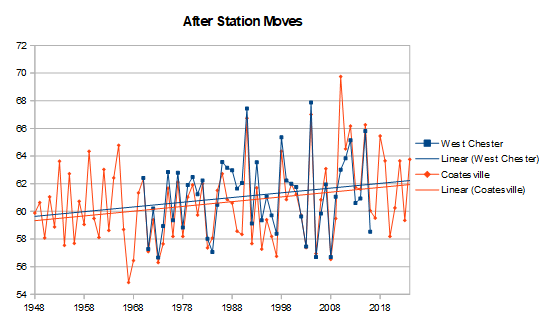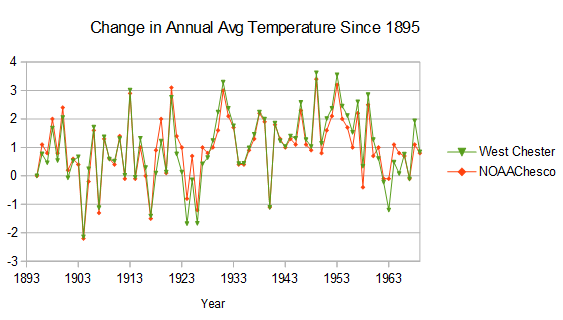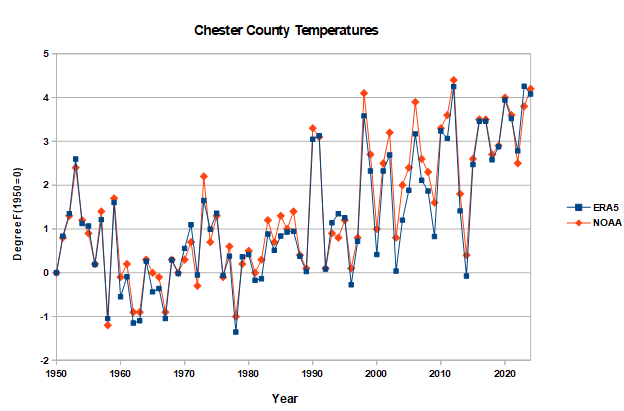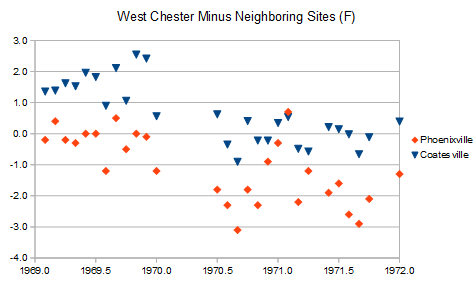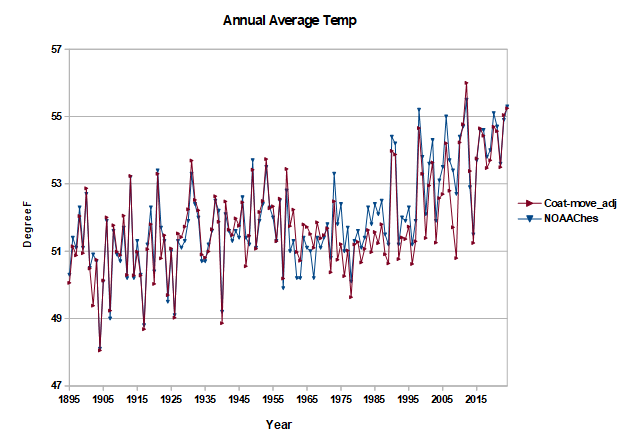
chubbs
Members-
Posts
4,041 -
Joined
-
Last visited
Content Type
Profiles
Blogs
Forums
American Weather
Media Demo
Store
Gallery
Everything posted by chubbs
-
Chester County PA - Analytical Battle of Actual vs. Altered Climate Data
chubbs replied to ChescoWx's topic in Climate Change
Your being confused by station moves. We've been over the importance of West Chester and Coatesville station moves a zillion times. The moves were large enough to obscure the real climate trend. As shown upthread, without the station moves there is no cooling at West Chester or Coatesville. Here's another way to remove the station moves: plot the before and after move data separately. Without the confusion of the station moves, West Chester and Coatesville are in good agreement on our local weather. Before the station moves, May temperatures were close to 62F at the two stations. After the moves they had cooled to 60F. The trend lines for West Chester and Coatesville both before and after the station moves are almost the same. There is no change in temperature before the station moves; and, warming after the station moves. Further confirmation that West Chester and Coatesville have warmed in May. The effect of the station moves is easily seen by comparing the regression lines around the time of the moves. Immediately before the station moves, May temperatures were close to 62F at the two stations. After the moves they had cooled to 60F. This example shows the value of bias-adjustment. As Coatesville and West Chester demonstrate, the raw data from a single station can be misleading when there are major station changes. This isn't rocket science. Knowing the station histories, it is easy for me to remove the station moves and get a more accurate climate trend that is close to NOAA. You could do the same. -
Nope, one station too warm or too cold doesn't bother me at all. We have thousands of temperature stations in the US and weather data is correlated for hundreds of miles. Easy to spot and correct stations with problems whether its sensors, station location, or change in local land-use (heat islands). The only thing that bothers me is claims that there is something wrong with our knowledge about recent temperature trends.
-
Chester County PA - Analytical Battle of Actual vs. Altered Climate Data
chubbs replied to ChescoWx's topic in Climate Change
You aren't showing any station data though. Zero. Just your network averages that are contaminated with station moves and network changes. If you want to argue that the other stations refute West Chester and Coatesville, show the actual raw station data. Good luck, because the other long-term station, Phoenixville, also shows slight warming. West Chester and Coatesville are the only Chesco stations with multi-decade periods with no significant station changes, during those periods the raw data is only responding to weather. We have had one set of weather in Chester County, that is well depicted by West Chester and Coatesville raw data and NOAA. The other stations don't show anything different. -
You are making a mountain out of a molehill. The Philly airport ran roughly a degree warm in 2022. The sensor was replaced and 2023 and 2024 are back to normal. Easy to track by comparing to nearby sites. NOAA and other experts won't be fooled.
-
Chester County PA - Analytical Battle of Actual vs. Altered Climate Data
chubbs replied to ChescoWx's topic in Climate Change
Nope. You don't know what the raw data shows. The raw data from West Chester and Coatesville shows warming in May. Not as much warming as March, but warming nonetheless. West Chester and Coatesville both have long periods where station changes were minor allowing the true climate trend to be determined. -
Chester County PA - Analytical Battle of Actual vs. Altered Climate Data
chubbs replied to ChescoWx's topic in Climate Change
Raw data from West Chester and Coatesville shows March has warmed significantly in Chester County. I'm sure April and May have similar amounts of warming. The evidence is overwhelming that our county has warmed significantly. -
Chester County PA - Analytical Battle of Actual vs. Altered Climate Data
chubbs replied to ChescoWx's topic in Climate Change
Nope again, I have provided the answer umpteen times. The stations that you complain about are in WARM locations. Warmer than the county as a whole. Its not accuracy; its location, location, location. Simple as that and the evidence is overwhelming. All you have to do is look at a map and land-use near the stations. The raw temperature data confirms the warmth of early measurement sites. The early stations are about as warm Wilmington, Philadelphia or the Newark ag station. As soon as the Coatesville and West Chester moved to cooler locations, more representative of the county as a whole, NOAA matched them closely. -
Chester County PA - Analytical Battle of Actual vs. Altered Climate Data
chubbs replied to ChescoWx's topic in Climate Change
Surprised that you aren't more familiar with the station data or histories. West Chester is very representative of the early Chesco coops. Similar in temperature to Coatesville pre-move, Sadsburyville, and Kennett Square, and cooler than Phoenixville. Looks like Sadsburyville is in also in a town, like the early Coatesville and West Chester stations. The 1948 Coatesville station is the first county station that is more representative of the county as a whole; and, NOAA matches it well. You can't understand the county climate history without studying the station network and how it has changed with time. Among other changes, there is a reverse heat-island effect in the Chesco stations as people and stations moved out of towns to more rural locations. -
Chester County PA - Analytical Battle of Actual vs. Altered Climate Data
chubbs replied to ChescoWx's topic in Climate Change
Nope. Of course I see that the older stations are warmer than NOAA. Perfectly understandable to me. The old Chesco stations are in warm locations. Before the 1970 move, West Chester was as warm as Wilmington. Why would anyone expect the Chester County average to be as warm as Wilmington? -
Chester County PA - Analytical Battle of Actual vs. Altered Climate Data
chubbs replied to ChescoWx's topic in Climate Change
If you account for the 1970 West Chester move, NCEI is spot on. West Chester and Coatesville cooled at different times: Coatesville after the war and West Chester in 1970. Station moves not weather. Agree that facts always win out, but you can't pick and choose. -
Chester County PA - Analytical Battle of Actual vs. Altered Climate Data
chubbs replied to ChescoWx's topic in Climate Change
Nope again. The difference in the trend-lines is mainly due to the Coatesville post-war move. In comparison West Chester closely matches NOAA with no cooling. How many times do we have to go over the same material showing that the raw Chesco data is contaminated by station moves and other non-climate related changes. -
Chester County PA - Analytical Battle of Actual vs. Altered Climate Data
chubbs replied to ChescoWx's topic in Climate Change
Nope. The plot is raw data from three Coatesville stations, the two coops and the Coatesville Airport since 2007. The Coatesville stations are different but well matched. I could have used your house instead of the airport and the plot wouldn't have changed much. Your criticism of NOAA is just a denier strawman. No data has been changed, made up, altered, or chilled. The truth is exactly the opposite. NOAA has isolated the real Chesco climate trend from all the station and network changes. The evidence is overwhelming. All the datasets that have a long record of consistent data agree with NOAA. -
Chester County PA - Analytical Battle of Actual vs. Altered Climate Data
chubbs replied to ChescoWx's topic in Climate Change
Coatesville raw data is in very good agreement with NOAA and ERA5. All the data confirm that NOAA is spot on with our local warming. -
Chester County PA - Analytical Battle of Actual vs. Altered Climate Data
chubbs replied to ChescoWx's topic in Climate Change
There is complete agreement on Chester County's climate between NOAA and ERA5 reanalysis. A big feather in NOAA's cap because the two series are independent, different data and methods. -
Chester County PA - Analytical Battle of Actual vs. Altered Climate Data
chubbs replied to ChescoWx's topic in Climate Change
Nope, can't agree. You are playing word games instead of addressing the technical content of my comment. We've been going over NOAA's Chesco climate analysis for some time now. Nothing is being changed or distorted by NOAA, On the contrary, bias-adjustment has made a big improvement in the information we have about Chester County's climate. NOAA nailed the big station moves at Coatesville and West Chester, and the warmth at Phoenixville in the 1930-50s. Of course the bias-adjusted values are different that the raw values. That is intentional, to separate station moves from real climate changes. You can't get our climate right without accounting for the changes in the temperature measuring network. You keep complaining about the how cool NOAA is vs. the raw Chesco data. But the data doesn't support your assertion. You can't draw conclusions about the raw data without considering where the measurement was made. We just went over the 1940 to 1970 period. There were only 4 stations in that period and all are warmer than Chester County as a whole: The built-up sections of Coatesville and West Chester, Phoenixville, and West Grove. All south and east. As warm as Wilmington or Philadelphia at times. Phoenixville is always warmer than NOAA today. Coatesville and West Chester cooled to NOAA's county average as soon as they moved to cooler locations. How about your analysis. You aren't getting the correct climate information from the raw data. Taking a simple average discards all of the information about where measurement was taken. The City of Coatesville is not the same as the rural area nearby, or Warwick, or any other station. The simple averages improperly combine the station and network changes into the climate estimate. That causes a large error given all the station changes in Chester County. You have made our past climate too warm, solely because the early station network is not representative of the county as a whole. Very easy to see in the chart I posted above. -
Chester County PA - Analytical Battle of Actual vs. Altered Climate Data
chubbs replied to ChescoWx's topic in Climate Change
What are you afraid of in the non-Chesco data? Its a red flag in any technical analysis when someone wants to exclude data without providing any technical justification, a sure sign of a flawed analysis. Not that non-Chesco data is needed to validate NOAA. Anyone familiar with the county can recognize the large shifts in the Chesco station network with time. The early network was restricted to warmer sites mainly towns in the south and east. The cooling station moves at Coatesville and West Chester are easily detected using Cherster County raw data. Chesco data also flags the warm readings at Phoenixville in the 1930-50s. Finally, as shown above, when the station moves are accounted for the Chesco station data tracks NOAA's series closely. The fact that both the Chesco and non-Chesco data validate NOAA's analysis is exactly what you expect from a technical analysis that reflects the real world. -
Chester County PA - Analytical Battle of Actual vs. Altered Climate Data
chubbs replied to ChescoWx's topic in Climate Change
West Chester 2NW has al long history, many sites including the Daily Local. Here is a map of 2NW locations from the NOAA Observing Data Metadata Laboratory (link below). In 1970 the station moved from the middle of West Chester (site 6) to the Daily Local News office on the western outskirts of town (site 5). In 1998 the station moved to the observer's house (site 1). Easy to see the effect of the 1970 move by comparing West Chester to other County stations. Below is a plot of monthly data before and after the move for West Chester, Coatesville and Phoenixville. The West Chester station closed at the old location at the end of the year in 1969 and re-opened at the new location in May 1970. I removed the annual temperature cycle by subtracting Coatesville and Phoenixville from West Chester. A lower value means West Chester cooled relative to the other stations. The chart shows roughly 2F cooling at the West Chester station that coincided exactly with the move. The raw data is conclusive on the move effects. https://www.ncei.noaa.gov/access/homr/#ncdcstnid=20016596&tab=LOCATIONS -
Chester County PA - Analytical Battle of Actual vs. Altered Climate Data
chubbs replied to ChescoWx's topic in Climate Change
Funny, ILG is only 12 miles from my house, closer than Coatesville, West Chester, East Nantmeal; hardly "far away". No you are the one who isn't supported by raw data. The year-to-year temperature change at Coatesville and West Chester tracks PHL, ILG, and ABE closely when there isn't a station change, making the Coatesville and West Chester station moves east to detect. In the early 1940s, Coatesville and West Chester were as warm as the Philadelphia airport. After the station moves moves both stations were as cool as Allentown: Coatesville after 1948, and West Chester after 1970. Between the 1948 and 1970 Coatesville was much cooler than West Chester. The chart info is not surprising. The atmosphere doesn't know or care about the Chester County border. Weather data is correlated for hundreds of miles. Year-to-year temperature changes at PHL, ILG and ABE are all highly correlated with year-to-year temperature changes in Chester County. There is no reason to reject valuable data from outside the county. Particularly when you consider the quality and consistency of the NWS main climate sites. -
Chester County PA - Analytical Battle of Actual vs. Altered Climate Data
chubbs replied to ChescoWx's topic in Climate Change
I removed the fake data from your table (see post above) and updated what you are calling "Actual Chesco" by recalculating the network average. The fake data ran warm so the updated "actual Chesco" is somewhat cooler than your Table, closer to NOAA. However, even after the update, "Actual Chesco" is an outlier vs the other regional data. "Actual Chesco" is almost as warm as the Philadelphia Airport (PHL) and Wilmington (ILG) in the 1940s; but, cools with time, becoming almost as cool as Allentown (ABE) and NOAA in the 1970s. The relative cooling of "Actual Chesco" between the 1940s and 1970s is caused by the station moves at Coatesvile (1946-47) and West Chester (1970), and Phoenixville recovering from the warm bias of the 1930-50s. "Actual Chesco" is a a misnomer, doesn't follow our actual weather at all due to all of the changes in the station network that are not accounted for. -
March was cooler than last year according to ERA5. Year-to-date, this year is running 0.05C cooler than last year.
-
Chester County PA - Analytical Battle of Actual vs. Altered Climate Data
chubbs replied to ChescoWx's topic in Climate Change
Every time I look at your stuff I find more problems. The table above has fake or estimated data for Chadds Ford, Glenmoore, and partially for West Grove. Per NCDC, Chadds Ford and Glenmoore were precip only, while West Grove only has temperature data after April 1963. With your method, removing the fake data will change your result. That will be the third or fourth change to Chester County's climate you have made in the past year or two. Meanwhile NOAA is spot on. -
Chester County PA - Analytical Battle of Actual vs. Altered Climate Data
chubbs replied to ChescoWx's topic in Climate Change
Glad to see Grok make good use of the information in the Table. The table was criticized as "unscientific" by our local "expert" when it was originally posted -
Chester County PA - Analytical Battle of Actual vs. Altered Climate Data
chubbs replied to ChescoWx's topic in Climate Change
You are in dismissal mode. Throwing out the same old whatabouts. What about this. What about that. If you want the answer to your questions look at the material I have posted above. As an example, between 1945 and 1948, Coatesville moved twice and West Chester didn't. Between 1945 and 1948, Coatesville cooled by 2.1F, while West Chester only cooled by 0.3F. Using West Chester data alone justifies a 1.8F cooling adjustment to the pre-move Coatesville data. But there are many more stations besides West Chester that support the Coatesville bias adjustment. NOAA and other groups use the year-to-year changes to make bias adjustments. Why?, year-to-year temperature changes are correlated for hundreds of miles. Within a region, year-to-year temperature changes that occur at all stations are weather-related; but, year-to-year changes that occur at only one station are due to station changes not weather. When you have thousands of stations, with overlapping correlation across the county, the procedure is bullet-proof. Per chart, Allentown agrees with West Chester on the flat temperature trend between 1945 to 1948; and, there are many more regional stations that support West Chester and Allentown. The correlation of year-to-year temperature changes goes way beyond the border of Chester County. A cool year in Chester County is a cool year in the entire Mount Holly service area and beyond. The adjustments are based entirely on raw data. No, there's no doubt that the Coatesville cooling between 1945 and 1948 was due to a station move and not weather. The raw data is the proof. Now its your turn. Where's your validation? You are treating the Coatesville cooling between 1945 and 1948 as completely weather-related. Where's the evidence to support that. Same question for West Chester in 1970. You also need to justify using the City of Coatesville, the Borough of West Chester, the Borough of Kennett Square and Phoenixville as a county average. Finally to justify a simple average, you need to show that the station network doesn't change with time. Good luck with that. -
Chester County PA - Analytical Battle of Actual vs. Altered Climate Data
chubbs replied to ChescoWx's topic in Climate Change
When adjusted for the post-WWII station moves to a cooler location, the Coatesville data agrees very well with the NOAA county temperature series; over the entire record back to 1895. The move-adjusted series uses raw data from 3 Coatesville stations since 1948 and NOAA bias-adjustments before 1948 when the 1SW station moved between several Coatesville city sites. The Coatesville data, properly corrected for station moves, is a very good proxy for the county-average temperature. Once again NOAA is spot on. -
Earth's storage of water in soil, lakes and rivers is dwindling. And it's especially bad for farming Their paper, published Thursday in the journal Science, finds that global warming has notably reduced the amount of water that's being stored around the world in soil, lakes, rivers, snow and other places, with potentially irreversible impacts on agriculture and sea level rise. The researchers say the significant shift of water from land to the ocean is particularly worrisome for farming, and hope their work will strengthen efforts to reduce water overuse. Earth's soil moisture dropped by over 2,000 gigatons in roughly the last 20 years, the study says. For context, that's more than twice Greenland's ice loss from 2002 to 2006, the researchers noted. Meanwhile, the frequency of once-in-a-decade agricultural and ecological droughts has increased, global sea levels have risen and the Earth's pole has shifted. https://phys.org/news/2025-03-earth-storage-soil-lakes-rivers.html


